Bronze Age debris hoard 'like a recycling bin'
 David Stuckey
David StuckeyA hoard of metal fragments found on farmland was the Bronze Age equivalent of a modern-day recycling bin, an expert said.
The stash of copper-alloy debris, dating back more than 2,000 years, was found by a metal detectorist David Stuckey from Stevenage in a field in Guilden Morden, Cambridgeshire, in December 2019.
The county's finds liaison officer, Helen Fowler, said the hoard was most likely deposited in one go to be melted down later, once there was enough metal to make the process worthwhile.
"The hoard is like our blue recycling bins here [in parts of Cambridgeshire]," she said.
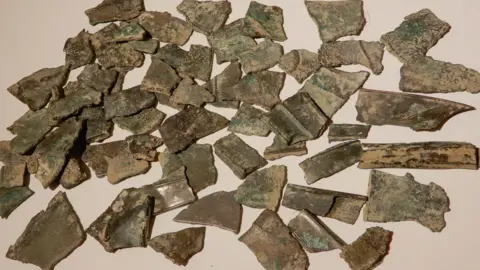 David Stuckey
David StuckeyThe hoard is the subject of a treasure inquest and Cambridge University's Museum of Archaeology and Anthropology hopes to acquire it, subject to valuation.
The 66 fragments date from the late Bronze Age - between 1050BC and 800BC - and include chapes, pieces of metal used to protect the sharp end of a bladed item such as a sword.
In a report to the Cambridgeshire coroner ahead of a decision on whether it should be declared treasure, Mrs Fowler and colleague Dr Edward Caswell, finds liaison officer for Oxfordshire, referred to the items as a "founder's hoard".
The term is used to describe a collection of bits and pieces gathered together by a metalworker - or a smith, or a founder - for re-melting at a later date.
The report stated: "The objects were found in close proximity and are associated, therefore representing a single find all of which appears to have been deposited in the late Bronze [Age].
"As such this represents a collection of more than two base metal objects of prehistoric date and consequently qualifies as Treasure under the stipulations of the Treasure Act 1996 (Designation Order 2002)."
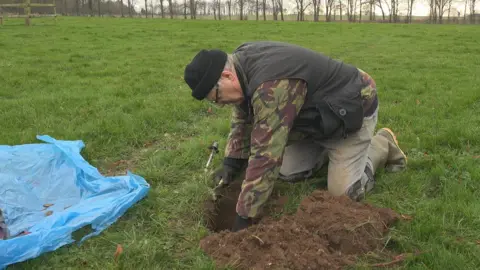 David Stuckey
David Stuckey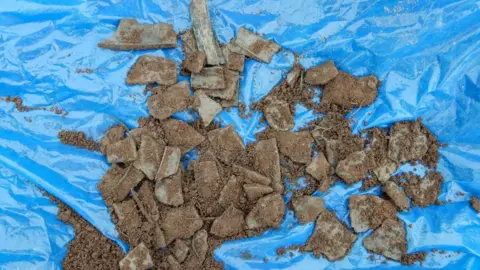 David Stuckey
David StuckeyMr Stuckey, 69, said he had been detecting on the land where he found the hoard for about seven years.
"About a foot down I suddenly saw fragments of green-coloured metal coming out of the hole. I picked up the pieces and could see that they were bronze fragments of 'something'," he said.
"As more pieces came out I noticed that some of them had identifiable characteristics of Bronze Age metalwork.
"Afterwards I showed the hoard to the landowner, who was very excited by what I'd found."
Mr Stuckey said there were Bronze Age barrows (burial mounds) on the land, so to find artefacts from that period was of great interest to its owner.
"Being pre-historic I was obliged by law to report the find," he explained.
However, there was a significant delay because of the Covid-19 pandemic, meaning he could not deliver the hoard to be properly assessed by an expert.
"It was quite some time before I was asked to bring the hoard in, followed by a two-year wait until I heard anything more," he said.
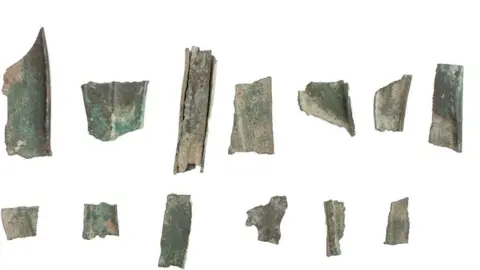 Oxfordshire Museums Service
Oxfordshire Museums Service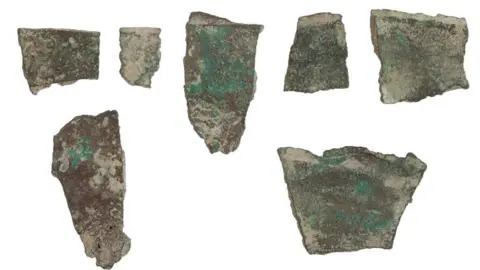 Oxfordshire Museums Service
Oxfordshire Museums ServiceThe hoard contained a number of "plate fragments" that Mrs Fowler said were the most intriguing to her.
She said "plates", generally, were "a bit of a mystery" to archaeologists.
"We're not sure what they are yet, but mystery is one of the nice things about archaeology. There are more questions than answers - always," she said.
"There is lots of research to be done on these Bronze Age plates - we need to know more and that's what's most intriguing to me."
 David Stuckey
David StuckeyBut, whatever these items were, they were almost certainly destined for the scrap heap.
"We certainly didn't invent recycling and in the Bronze Age you would save up everything until you had enough to melt down for something else as the melting process takes a lot of work," said Mrs Fowler.
If the hoard was acquired by a museum, it would provide "the potential for future research, and that's what is important", she added.
Follow Cambridgeshire news on BBC Sounds, Facebook, Instagram and X.
